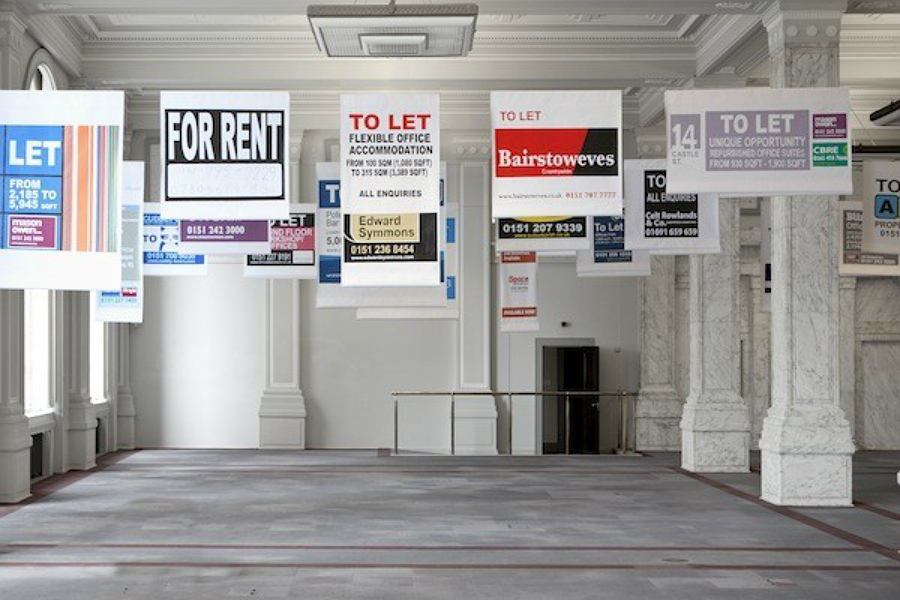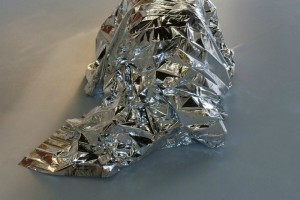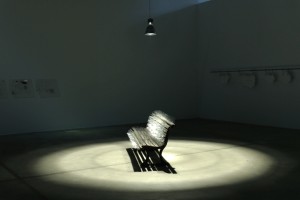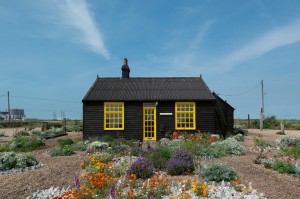Biennial 2012: The Cunard Building

C James Fagan on feeling very much like an unexpected guest at the Cunard building…
This piece is the result of two visits to the Cunard Building; when faced with something as large as a Biennial you have to rethink your approach. I wonder if I should be regarding the individual works, this exhibition or the Biennial as a whole. So there are already a number of issues before I even get there.
Upon arriving at the grandiose Cunard building I turn right, into a large room dominated by marble columns, dark wood and a grey and red carpet. Distracted by my surroundings, I am a little lost in this space – I have no idea which direction to go, or where to begin.
I find myself underneath a series of banners: a collection of ‘To Let’ signs, the kind you see spread across any city, town or village across the UK. These are painstaking reproductions undertaken by the Danish-based collective, Superflex. On arriving in Liverpool, Superflex noticed a ubiquity of these signs and decided to reproduce them.
It feels like they’ve identified an issue – the number of properties that are empty due to the economic crisis – but haven’t offered an opinion about that issue. It feels like an observation and not much more than that. Maybe it’s a familiarity with these signs, and more importantly, the remaining empty space which robs these reproductions of any further impact.

Craning my neck upwards I nearly miss Pamela Rosenkranz’s sculptures. At first they appear as gold and silver nuggets. Only when I walk through them do human figures reveal themselves. Tracking down an information board I find that these pieces are made from emergency blankets. This got me wondering whether the figures are cowering from the grand structure of capitalism which surround them, or are they waiting for that structure to fall so they can emerge from the rubble.
Drifting forward I find myself in a room containing a series of neat black and white photographs of people looking at art. So I’m in a room looking at art of people looking at art. I don’t know whether I’m being asked a question about how we judge and value art and culture or just to enjoy some old snapshots.
I move on to another room featuring a battered sculpture by Runo Lagomarsino of a parrot perched upon a wooden crate, trying to ignore its brighter cousin in a poster advertising tours down the Amazon. Maybe it’s pining for the fjords, or the Amazon equivalent. It’s also possible that this piece is a question regarding spent exotica, the picking from one culture to feed another. Judging by the title An Offensive Object in the Least Offensive Way, I guess I’m on the right track.
Opposite is one of Mona Hatoum’s pieces, the first I encounter in what you could consider an ‘mini exhibition’ of her work. As she is quite well known if feels difficult to write about her work within the context of the Cunard space. Though it seems that her piece Testimony fits the Biennial’s general theme of hospitality as it offers an endoscopic view of the human body. If that’s not being hospitable, I don’t know what is. Thinking about the piece in that way adds an unexpected level of humour. I wonder if that was the intent.
I cross the grand hall, passing another Hatoum piece and a bright sign proclaiming City of Sanctuary. There is no other information. After looking in the booklet I discover this is the branding for a scheme seeking to ensure people can find a safe and welcoming place wherever they are. It may have been beneficial to have some relevant information regarding the City of Sanctuary; otherwise I’m just looking at a groovy logo.
Moving on, I’m in another grey room, where one wall has the legend ‘I know someone, do you?’ This is part of Storying Rape by Suzanne Lacy. Initially quiet, soon the room is filled by the voices of people honestly detailing their experiences of rape. As the voices build it becomes a representation of the issues surrounding rape and the fact that attitudes aren’t really addressed by men or women, resulting in a lack of ‘resolution’.
A hugely complex issue, Three Weeks in January is an attempt to open up a dialogue which extends outside of the gallery space. This makes it one of the more successful pieces, as it engages with the questions it raises rather than providing simple observation.
On the opposite side of the Cunard building I find a different space dominated by large monoliths covered in bright patterns. Soon a Russian girl appears on one and begins her polemic. These are Sylvie Blocher’s re-stagings of political texts. Each staging is meant to bring a new context. Not familiar with the texts, I can’t really judge it on that basis, but they dominate this space in a way the other works can’t.
In the middle of this piece is a henge of monitors, each with a view of a block of flats. We are guests in these spaces, an unexpected stranger in someone else’s life. A sensation compounded when a figure appears on the screen and I’m no longer benign observer but voyeur. Looking in the booklet this doesn’t appear to be Mikhael Subotzky’s intent, though by granting me access into these lives, without context, I question my ability to judge the lives of others.
Moving toward the shining light that is Trevor Paglen’s Non-functional Satellite. I don’t know about this piece; on one side the idea of producing something that doesn’t work is quite an amusing idea that touches on the idea of the value of work, but the idea of the sinister dual functions of satellites doesn’t come across.
Beyond the satellite is Althea Thauberger’s restaging of Marat Sade. The piece is staged in the Bohnice Psychiatric Hospital in Prague. It is a really interesting idea and the play sounds fascinating. This is the problem. What we are presented with feels more like a document of a piece which leads me to think I’ve missed out on a singular experience.
Nearby, there’s more work with a good idea at its core. Ahmet Ogut set forth a messenger to go between Manchester and Liverpool to announce and invite people to the Liverpool Biennial. There is a Romantic notion here, something that circumvents the banalities of contemporary communication technologies.

Leaving this space I pass a nasty looking park bench which I initially mistake for another Mona Hatoum piece but more on that in a bit. I’m drawn towards the sound of chanting. Entering the space, I’m greeted by a congregation of people stood behind pews signing in unison the word ‘No’. Opposite is a set of disembodied lips from which emits – sweetly – the questionnaire that forms part of the visa application process.
It shows the relative absurdity of this kind of bureaucracy, the kind of bureaucracy that asks ‘Have you ever committed genocide’; surely a redundant question. It also makes me think about how our freedom to move around isn’t as easy as we like to think. The piece deals with its concepts with a certain amount of wit, a sense of humour which is missing from other works dealing with socio-political issues.
Seeing this makes me re-address the park bench, also by Nadia Kaabi-Linke. This works along the same lines as the video installation, calling attention to the contradictions in inviting people in to a country, while ensuring they never feel comfortable enough to stay.
That turns out to be the final piece I see. Trying to make sense of what I’ve seen, there were times where I was ‘lost’, not knowing how to approach the work, how to engage with it. I found myself looking for something which would help me understand the context in which the work had been made – the whole exhibition had felt like an intellectual exercise.
I kept thinking to myself ‘I know this but I don’t feel this’ – I found myself wanting to form an emotional connection to the works to help me engage more. Two examples in which I found that connection weere the works by Suzanne Lacy and Nadia Kaabi-Linke. It’s not that I found my time at the Cunard unrewarding, just that as is often the case with exhibitions of this scale, the effect of some artworks can be muted.
This also could be an opportunity for us, the citizens of this city, to revisit the works involved in The Biennial and in doing so develop a sense of attachment to them: there are works here which both please and challenge. Of course, this is risk you take when you become an unexpected guest.
C James Fagan
The Biennial continues in various venues across the city until 25th November





